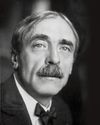
The street corners of downtown Rapid City, South Dakota, the gateway to the Black Hills and the self-proclaimed “most patriotic city in America,” are populated by bronze statues of all the former Presidents of the United States, each just eerily shy of life-size. On the corner of Mount Rushmore Road and Main Street, a diminutive Andrew Jackson scowls and crosses his arms; on Ninth and Main, a shoulder-high Teddy Roosevelt strikes an impressive pose, holding a petite sword.
As one drives farther into the Black Hills—a region considered sacred by its original residents, who were displaced by settlers, loggers, and gold miners—the roadside attractions offer a vision of American history that grows only more uncanny. Western expansion and settler colonialism join in a jolly, jumbled fantasia: visitors can tour a mine and pan for gold, visit Cowboy Gulch and a replica of Philadelphia’s Independence Hall (“Shoot a musket! Exit here!”), and stop by the National Presidential Wax Museum, which sells a tank top featuring a buff Abraham Lincoln above the slogan “Abolish Sleevery.” In a town named for George Armstrong Custer, an Army officer known for using Native women and children as human shields, tourist shops sell a T-shirt that shows Chief Joseph, Sitting Bull, Geronimo, and Red Cloud and labels them “The Original Founding Fathers,” and also one that reads, in star-spangled letters, “Welcome to America Now Speak English.”
この記事は The New Yorker の September 23, 2019 版に掲載されています。
7 日間の Magzter GOLD 無料トライアルを開始して、何千もの厳選されたプレミアム ストーリー、9,000 以上の雑誌や新聞にアクセスしてください。
すでに購読者です ? サインイン
この記事は The New Yorker の September 23, 2019 版に掲載されています。
7 日間の Magzter GOLD 無料トライアルを開始して、何千もの厳選されたプレミアム ストーリー、9,000 以上の雑誌や新聞にアクセスしてください。
すでに購読者です? サインイン

HOLIDAY PUNCH
\"Cult of Love\" on. Broadway and \"No President\" at the Skirball.

THE ARCHIVIST
Belle da Costa Greene's hidden story.

OCCUPY PARADISE
How radical was John Milton?

CHAOS THEORY
What professional organizers know about our lives.

UP FROM URKEL
\"Family Matters\" and Jaleel White's legacy.

OUTSIDE MAN
How Brady Corbet turned artistic frustration into an American epic.

STIRRING STUFF
A secret history of risotto.

NOTE TO SELVES
The Sonoran Desert, which covers much of the southwestern United States, is a vast expanse of arid earth where cartoonish entities-roadrunners, tumbleweeds, telephone-pole-tall succulents make occasional appearances.

THE ORCHESTRA IS THE STAR
The Berlin Philharmonic doesn't need a domineering maestro.

HEAD CASE
Paul Valéry's ascetic modernism.